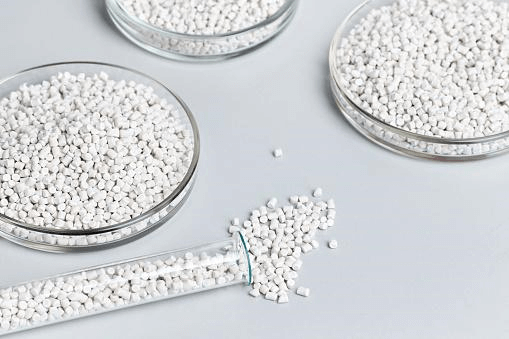There are two main classes of polymers: Thermoset plastics, and thermoplastics. While the names of these two kinds of plastic may seem similar, they actually have several key differences. These differences can influence the performance of these plastics, making them ideal for different use cases.
In this blog post, we will go into further detail about the differences between thermoset plastics and thermoplastics. By understanding the differences in properties, benefits, and use cases, your organization will be able to make better sourcing decisions and product designs.
What Are Thermoplastics?
Thermoplastics are a class of polymer that maintains the same chemical structure, no matter if it’s a liquid or a solid. This allows it to be formed into a solid and melted again by applying heat. Think of thermoplastics like butter – it can be purchased in a solid form, then it can be melted with heat, and it will return into a solid form upon being cooled – with no discernible changes throughout the heating and cooling process.

When a manufacturer purchases a thermoplastic, they often purchase tiny plastic pellets. These pellets are then evenly heated until they shift into their liquid form. Then, the molten plastic is poured into a mold, where it is then cooled into its desired shape.
Since no chemical bonds are formed during this process the forming of a thermoplastic, the plastic can be reheated, remolded, and cooled without impacting its physical properties, making it an ideal candidate for recycling. As a result, thermoplastics are often sought after to fulfill sustainability initiatives.
The downsides of thermoplastics are limited. Of course, they can melt, making them inappropriate for heat-focused applications. They’re also more expensive than thermoset plastics, on average. However, this higher price tag is often justified due to the various benefits of thermoplastics. They have high-impact resistance, chemical resistance, and shrink resistant. They’re also available in both hard crystalline and rubbery surface options.
Common Uses for Thermoplastics
Thermoplastics are commonly used for consumer goods. Since these products are never exposed to high levels of heat, it’s suitable to manufacture them out of a thermoplastic. Best of all, these products can be marketed as recyclable to environmentally conscious shoppers. Here are a few types of common thermoplastics and a few common use cases:
- ABS – Chances are, you’re using ABS plastic right now! It’s common for a keyboard’s keycaps to be made out of ABS, but they’re also commonly used in products like LEGO blocks and automobile parts.
- Polycarbonate – Almost everyone owns a polycarbonate product. For example, reusable food storage containers and plastic reusable water bottles are typically made from polycarbonate. Polycarbonate is exceptionally impact resistant, and can even be used as bulletproof glass.
- Polyethylene – Polyethylene is a very common thermoplastic, and is often used to create plastic grocery bags or single-use plastic products like shampoo or water bottles.
- Acrylic – Acrylic is commonly used for consumer goods. If you own a recently manufactured aquarium or terrarium, it’s likely made of acrylic plastic.
What are Thermoset Plastics?
Once thermoset plastics have been cooled, they are permanently solid. If a thermoplastic is like butter, then thermoset plastics are like egg whites. They begin as a liquid and become solid when heat is applied. However, there’s no way to turn solid egg whites back into a liquid – instead, heating it will only burn it.
Like egg whites, thermoset plastics undergo a fundamental chemical change during synthesis. They’re often created via reactive injection molding, which forms irreversible bonds between monomer chains. This bonding process is what makes thermoset plastics incapable of melting.
The biggest downside of using thermoset plastics is that they cannot be reshaped due to heat resistance. So, it’s impossible to recycle thermoset plastics or alter their form in any way. However, this heat resistance is a boon for high-temperature applications. In addition to being heat resistant, thermoset plastics also have a highly flexible design, good dimensional stability, and are much more cost-effective than thermoplastics.
Common Uses for Thermoset Plastics
There are a wide variety of thermoset plastics, some of which rely on their heat resistant properties more than others. For example, they can be used as a cost-effective way to replace metal parts in settings where thermoplastics would simply melt. Other use cases rely on their strong setting properties. Here are a few well-known thermoset plastics, and common use cases for each:
- Vinyl Ester – These resins are usually used to create laminates and coatings that provide protection from heat.
- Polyurethanes – Polyurethane is often used in coatings, foam seals, and even as the wheels on your grocery shopping cart. As well, synthetic sponges are often made from polyurethane.
- Epoxy – Epoxy resin is a liquid thermoset plastic, and upon setting it forms a solid bond that’s difficult to break. This is often used for adhesive purposes, but it can also be found in consumer goods like snowboards and bicycles.
Thermoplastics vs. Thermoset Plastics: Key Takeaways
The choice between a thermoplastic or thermoset plastic depends heavily on the use case. Typically, it is more common to see thermoplastics being used in day-to-day life. However, engineers that need to work with specialty plastics often need to call on the heat resistant properties of thermoset plastics.
For a more environmentally friendly material that can be reformed easily, choose a thermoplastic. For special applications that demand high heat resistance or cost-effective materials, thermoset materials may be preferable. If you’d like to take a look at a selection of our plastics, start by taking a look at our selection of acrylic, polycarbonate, or engineering plastics. Or, if you have any questions, contact us today.

